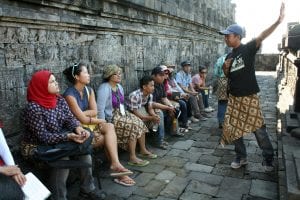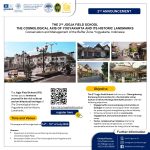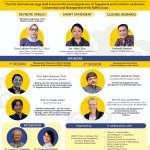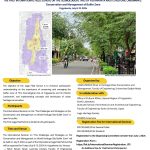BFS 2012 participants were assigned a study on the Borobudur National Strategic Area and
were divided into four groups to discuss specifc themes:
- environment
- spatial planning
- tourism
- architecture.
Environment
In considering how to conserve the National Strategic Area, the Environment Group discussed:
- environmental concerns:
– pollution of river and surrounds
– ecological footprint from litter – a combination of lack of awareness and lack of
proper garbage disposal facilities
- initial ideas to address the problems:
– fish ponds beneft land
– the grass verges and roadside trees are both picturesque and benefcial
– wise use of water resources
– rice farming along the highway corridor is picturesque, but use of pesticides is
degrading the environment
– we must not presume to teach the farmer about paddy planting or fsh farming; the
locals used to have innate knowledge of environment.
Spatial planning
The Spatial Planning Group considered cultural landscape heritage planning for the National
Strategic Area based on nature. Borobudur was built on the Kedu Plain, and the mountains,
hills, and rivers are part of the saujana heritage of the Borobudur area. The ancient lake is also
part of the history of the cultural landscape.
A draft spatial plan proposed mixed land use and farming in Palbapang:
- along Borobudur/Ngrajek roads
- small farms and fshing in Palbapang
- two kinds of government facilities to promote high-value tourist-orientated policies
(policies should not beneft local communities only as vendors).
Tourism
The Tourism Group listed the types of tourism around Pawon and Mendut temples:
- pilgrim tourism
- history tourism
- education tourism
- recreation tourism
- adventure tourism
- natural tourism
- cultural tourism
- ecological tourism
- culinary tourism.
The group also considered commitments in the tourism business:
- empowering local people
- benefts are mostly for local people
- open management
- maintaining environment and heritage
- promoting local cultures and products.
Architecture
The Architecture Group considered three zones/conservation areas and their guidelines:
- Zone 1: paddy felds and fsh ponds:
– strictly conserved area
– no businesses/construction allowed to disturb paddy felds and fsh ponds
– pedestrian zone introduced so people can enjoy the paddy felds and fsh ponds
- Zone 2: commercial
– current potential commercial development allowed
– no new applications/buying land for business use
– all business need a pedestrian zone
– limited to two stories high and to a local building style
– parking for owners around the back
– expansion needs to take the form of traditional houses (Jokulu style) instead of large
modern buildings
– business needs to maintain the vernacular method of building
- Zone 3:
– existing local business only allowed, no new construction
– introduce conversion of small local shops and residences to the local character
– only rentals allowed, priority given to local home industry or other kinds of adaptive
reuse
– pedestrian zone introduced.
The group also made suggestions for building new structures:International Borobudur Field School 2004–13 199
- to follow traditional dwelling architectural characteristics such as floor plans, roof style,
and bamboo features
- to ensure longer-lasting residences, allow the use of local-made bricks for walls (roofs,
doors, and windows to remain traditional bamboo style)
- to use traditional styles and materials for business buildings; however, in some instances,
allow brick walls in-between the bamboo mats.
- to use local style, scale, and materials for extensions (avoiding large buildings).
Participants of 6th BFS, 2012
Ain Noun Kornita Deny
Anne Yuen Kam Peng
Annika Eska Larasati
El Sabbahy, May Sherif
Erik Agus Saputra
Jinhua Tan, Selia
Kamsiah Mohammad Bostock
Mathew TK Cheng
Maya Raina
Priyo A. Sancoyo
Sigit Pramana Putra
Sinta Carolina
Su Mei Tan
Titin Fatimah
Vincentia Lucinda
Wahyu Nur Isnain Novianto
Wahyu Utami
Yeny Paulina Leibo
Yonanda Rayi Ayuningtyas




